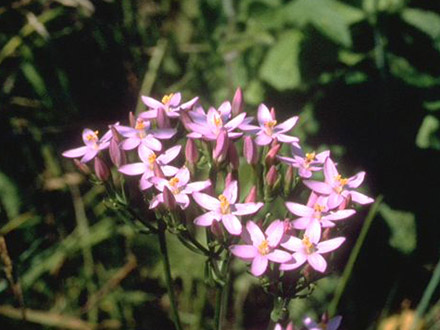Botanical name
Centaurium erythraea Rafn s.l.
Family
Gentianaceae
Common name
Common centaury, European centaury
Information about the plant
The plant grows with many regional subspecies across Europe, from the Mediterranean to the British Isles and Scandinavia, as well as in Northern Africa, North America, and Western Asia. The suffix ‘s.l.’ (sensu latiore = in the broader sense) after the botanical name indicates that the species is a multiform collective species. Other species, such as C. maus Zeltner and C. suffruticosum (Grieseb.) Ronn are also medicinally used.
The genus name Centaurium comes from the Greek ‘kentaureion’ (= belonging to the centaurs). The Centaurs are forest and mountain dwellers with healing powers; at the time of Homer, they were still depicted without the horse form that was later attributed to them. The species epithet erythraea (from the Latin ‘erythraeus’ = reddish) refers to the color of the pink flowers.
The English name refers simultaneously to the medicinal value of the plant, which could hardly be paid for with gold, and "aurei centum" (Latin), which means one hundred pieces of gold. Therefore, the plant was first called the hundred guilder herb and later, exaggeratedly translated as the thousand guilder herb.
The biennial plant grows to about 30 cm in height. In the first year, it forms a basal rosette of elliptical to spatulate leaves. In the second year, branched flower stalks with small stalk-leaves emerge. Ultimately, it produces pink, tubular flowers in 5-lobed, uneven cymes. The fruits are oblong, 2-fold dehiscent capsules containing many small seeds. The flowering time is from July to September.
Medicinally used parts of plants (herbal drug)
The above-ground parts of flowering plants, consisting of stems, leaves, and flowers, as well as a few capsules (Centaurii herba), are used.
The commercially available drug is imported from Morocco, the former Yugoslavia, Bulgaria, and Hungary.
Constituents of the herbal drug
Centaury contains bitter substances of the secoiridoid type.
Quality of the drug
The quality of centaury (Centaurii herba) is specified in the European Pharmacopoeia (Ph. Eur.).
Medical applications
Recognised medical use
The HMPC has classified centaury as a traditional herbal medicinal product (see ‘Traditional use’).
ESCOP: for dyspeptic complaints and loss of appetite.
Traditional use
Centaury has been classified by the HMPC as a traditional herbal medicinal product (Article 16a of Directive 2001/83/EC). Based upon long-standing use, centaury can be used for mild dyspeptic and gastrointestinal complaints and temporary loss of appetite.
Herbal drug preparations in finished dosage forms
- Cut centaury for tea preparation
- Powdered drug in coated tablets
- Alcoholic extracts in drops
- Centaurium erythraea homeopathic mother tincture
Dosage
Finished medicinal product: see patient information leaflet.
Tea: Drink a cup of warm centaury tea several times a day. It can also be combined with other herbs, such as wormwood and yarrow (stomach teas). The infusion should be consumed half an hour before meals to stimulate appetite and after meals for digestive complaints. Daily dose: 6 g of the drug.
Preparation of a tea
Pour 150 ml of boiling water over 2 to 3 g of finely chopped centaury and strain after 10 to 15 minutes.
Notes
Centaury should not be taken in the case of existing stomach ulcers.
No safety studies are available on the use of centaury during pregnancy and lactation. The use in children and adolescents under the age of 18 is not recommended due to a lack of evidence.
Side effects
None known.
Interactions
None known.
References
Herbal drug monographs
Further literature
Commentary on the European Pharmacopoeia (Centaury, No. 1301)


